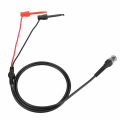STM32 digital output, ringing
- Thread starter ApacheKid
- Start date
Scroll to continue with content
No. Your oscilloscope is showing about 50ns ringing.Is this an inherent characteristic of the device and we need to use a capacitor to "filter" it out or what? It is just a 50% duty cycle, timer drive GPIO pin.
Make sure that you use a x10 attenuation probe AND the probe grounding clip is connected to circuit GND.
Ahh, thanks. I have one of these that's attached to the board's ground and the GPIO pin:No. Your oscilloscope is showing about 50ns ringing.
Make sure that you use a x10 attenuation probe AND the probe grounding clip is connected to circuit GND.

Here's the details.
panic mode
- Joined Oct 10, 2011
- 2,904
that seem to be just a BNC cable with clips - without compensation.
your scope must have square wave test point. do you see same ringing when this is connected to it?
check Figure 5 that shows what normal probe looks like. the trimmer capacitor is used to adjust this:
https://www.allaboutcircuits.com/technical-articles/an-introduction-to-oscilloscope-probes/
your scope must have square wave test point. do you see same ringing when this is connected to it?
check Figure 5 that shows what normal probe looks like. the trimmer capacitor is used to adjust this:
https://www.allaboutcircuits.com/technical-articles/an-introduction-to-oscilloscope-probes/
That is a simple BNC cable with no attenuation and no proper cable termination.
x1/x10 attenuation probe has a switch on the body of the probe to select x1 or x10 attenuation.
I always have my probes set to x10 attenuation. Before using the probe you need to adjust the trim capacitor for flat frequency response.

x1/x10 attenuation probe has a switch on the body of the probe to select x1 or x10 attenuation.
I always have my probes set to x10 attenuation. Before using the probe you need to adjust the trim capacitor for flat frequency response.

You mean 10 Megohm.A typical 10x scope probe has 1 MegΩ with 15 pF to Ground.
Where did you connect the probe's ground lead?I then re-attached the probe to the board, leaving everything set at 10X
It should be on the circuit ground close to the source of that waveform.
The probe ground is connected to one of several ground pins on the board, almost next to the signal output pin.Where did you connect the probe's ground lead?
It should be on the circuit ground close to the source of that waveform.
IndeedYou mean 10 Megohm.
Finally there was a 8 inch piece of wire between the probe ground crocodile clip and the board ground pin, I rearranged that and made it 1 inch (because the crocodile clip shorts against other pins):

I think I underestimated the impact of poor connection leads between device and scope, that seems to be the upshot of all this.

I think I underestimated the impact of poor connection leads between device and scope, that seems to be the upshot of all this.
It's one of the GPIO pins on the board, this is the board. It's GPIO 11 on port D.I have a question. What is the waveform source and what impedance is the source designed to work into.
Ron
8 inches is way too long.Finally there was a 8 inch piece of wire between the probe ground crocodile clip and the board ground pin, I rearranged that and made it 1 inch (because the crocodile clip shorts against other pins):
I think I underestimated the impact of poor connection leads between device and scope, that seems to be the upshot of all this.
If you want to do high frequency probing, here is what we use. That is less than 1 cm from the probe GND to the circuit GND.

That makes sense, but in this case the generated signal is just 27KHz, surely that's not what you'd call "high frequency"?8 inches is way too long.
If you want to do high frequency probing, here is what we use. That is less than 1 cm from the probe GND to the circuit GND.
View attachment 314403
No.That makes sense, but in this case the generated signal is just 27KHz, surely that's not what you'd call "high frequency"?
But it's not the fundamental repetition frequency that's the problem, it's the rise and fall times that have much higher Fourier frequencies which you must accurately resolve.
For a more-or-less linear rise and fall, the approximate equivalent highest frequency component is 0.35/τ where τ is the 10%-90% rise or fall time of the pulse.
From post #9, It looks like you original pulse fall time is <10ns, giving frequency components above 35MHz.
Last edited:














